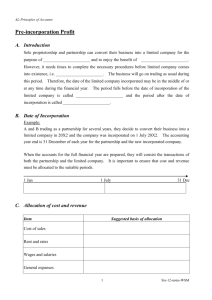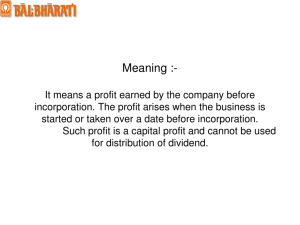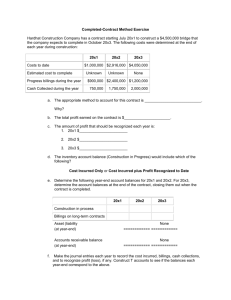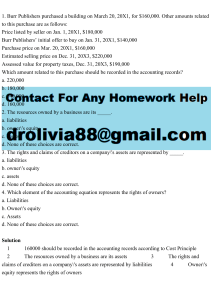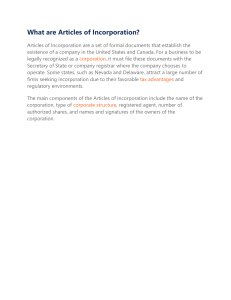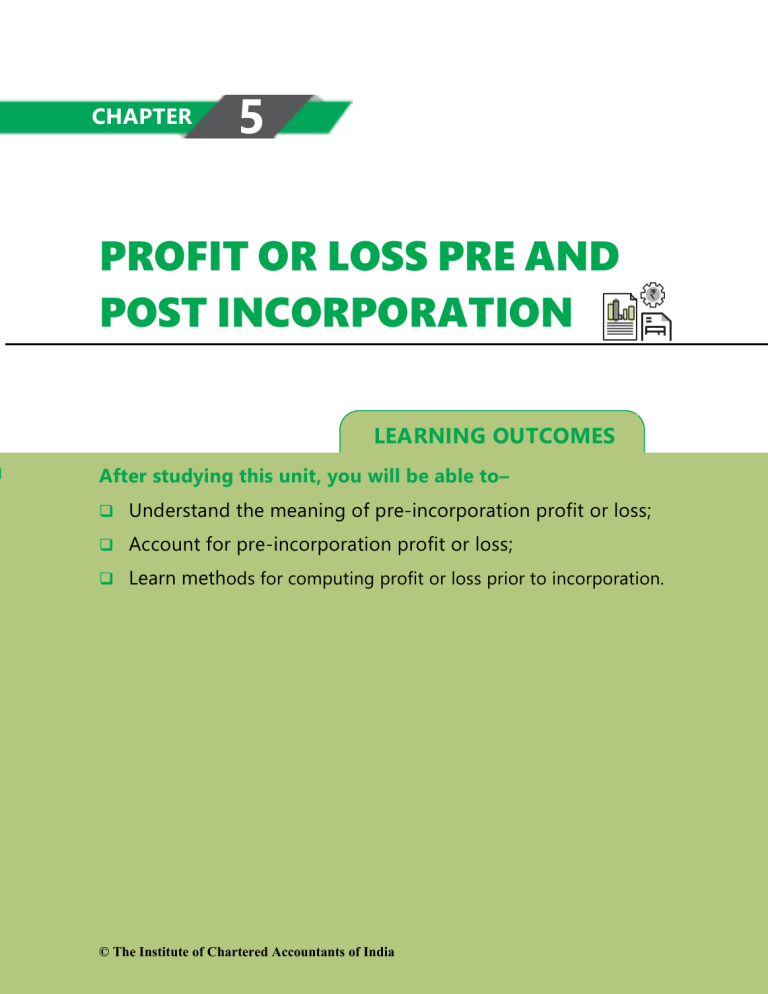
CHAPTER 5 PROFIT OR LOSS PRE AND POST INCORPORATION LEARNING OUTCOMES After studying this unit, you will be able to– Understand the meaning of pre-incorporation profit or loss; Account for pre-incorporation profit or loss; Learn methods for computing profit or loss prior to incorporation. © The Institute of Chartered Accountants of India 5.2 ACCOUNTING CHAPTER OVERVIEW Pre and Post Incorporation Profits/ Losses • Profit or loss of a business for the period prior to the date the company came into existence is referred to as Pre-Incorporation Profits or Losses. The chapter deal with the computation of such profits or losses and treatment thereof. 1. INTRODUCTION When a running business is taken over by the promoters of a company, as at a date prior to the date of incorporation of company, the amount of profit or loss of such a business for the period prior to the date the company came into existence is referred to as pre-incorporation profits or losses. Such profits or losses, though belonging to the company or payable by it, are of capital nature; it is necessary to disclose them separately from trading profits or losses. The general practice in this regard is that: i. ii. If there is a loss, (a) it is either written off by debit to the Profit and Loss Account or to a special account described as “Loss Prior to Incorporation” and show as an “asset” in the Balance Sheet, (b) Alternatively, it may be debited to the Goodwill Account. On the other hand, if a profit has been earned by business prior to the same being taken over and the same is not fully absorbed by any interest payable for the period, it is credited to Capital Reserve Account or to the Goodwill Account, if any goodwill has been adjusted as an asset. The profit will not be available for distribution as a dividend among the members of the company. 2. COMPUTING PROFIT OR LOSS PRIOR TO INCORPORATION The determination of such profit or loss would be a simple matter if it is possible to close the books and take the stock held by the business before the company came into existence. In such a case, the trial balance will be abstracted from the © The Institute of Chartered Accountants of India PROFIT OR LOSS PRE AND POST INCORPORATION 5.3 books and the profit or loss computed. Thereafter, the books will be either closed off or the balance allowed continuing undistributed; only the amount of profit or loss so determined being adjusted in the manner described above. The simplest, though not always the most expedient method is to close off old books and open new books with the assets and liabilities as they existed at the date of incorporation. In this way, automatically the result to that date will be adjusted, the difference between the values of assets and liabilities acquired and the purchase consideration being accounted for either as goodwill or as reserve. The accounts, therefore, would relate exclusively to the post-incorporation period and any adjustment for the pre-incorporation period, whether an adjustment of profit or loss, would not be required. Since the decision to take over a business is usually takes time from the date when it is agreed to be taken over it is normally not possible to follow any of the method aforementioned. The only alternative left, in the circumstances, is to split up the profit of the year of the transfer of the business to the company between ‘pre’ and ‘post’ incorporation periods. This is done either on the time basis or on the turnover basis or by a method which combines the two. 3. BASIS OF APPORTIONMENT Item Basis of Apportionment between pre and Post incorporation period Gross Profit or Gross Loss Sales Ratio-On the basis of turnover in the respective periods (first preference) Or On the basis of cost of goods sold in the respective periods in the absence of any information regarding turnover (second preference) Or Time Ratio-On the basis of time in the respective periods in the absence of any information regarding turnover and cost of goods sold (third preference) Variable Turnover expenses linked with Sales Ratio [e.g. Carriage/Cartage © The Institute of Chartered Accountants of India 5.4 ACCOUNTING outward, Selling and distribution expenses, Commission to selling agents/travelling agents, advertisement expenses, Bad debts, Brokerage, Sales Promotion] Fixed Common charges [e.g., Salaries, Time Ratio Office and Administration Expenses, Rent, Rates and Taxes, Printing and Stationery, Telephone, Telegram and Postage, Depreciation, Miscellaneous Expenses] Expenses exclusively relating to pre- Charge to pre-incorporation period Incorporation period [e.g. Interest on (but if the purchase consideration is Vendor’s Capital] not paid on taking over of business, interest for the subsequent period is charged to post incorporation period) Expenses exclusively relating to post- Charge to Post-incorporation period incorporation period [e.g. Formation expenses, interest on debentures, director’s fees, Directors’ remuneration, Preliminary Expenses, Share issue Expenses, Underwriting commission, Discount on issue of securities. Audit Fees (i) For Company’s Audit under the Charge to Post-incorporation period Companies Act. (ii) For Tax Audit under section On the basis of turnover in the 44AB of the Income tax Act, respective periods 1961 Interest on purchase consideration to vendor: (i) For the period from the date of Charge to Pre-incorporation period acquisition of business to date of incorporation. (ii) From the date of incorporation Charge to Post-incorporation period © The Institute of Chartered Accountants of India PROFIT OR LOSS PRE AND POST INCORPORATION 5.5 Calculation of time ratio and sales ratio Example Lion Ltd. was incorporated on 1.8.20X1 to take over the running business of M/s Happy with assets from 1.4.20X1. The accounts of the company were closed on 31.3.20X2. The average monthly sales during the first four months of the year (20X1-X2) was twice the average monthly sales during each of the remaining eight months. Calculate time ratio and sales ratio for pre and post incorporation periods. Solution Time ratio: Pre-incorporation period (1.4.20X1 to 1.8.20X1) = 4 months Post incorporation period (1.8.20X1 to 31.3.20X2) = 8 months Time ratio = 4 : 8 or 1 : 2 Sales ratio: Average monthly sale before incorporation was twice the average sale per month of the post incorporation period. If weightage for each post-incorporation month is x, then Weighted sales ratio = 4 × 2x : 8 × 1x = 8x : 8x or 1 : 1 4. PRE-INCORPORATION PROFITS & LOSSES S. No 1. 2. Pre-incorporation Profits Pre-incorporation Losses It is transferred to Capital Reserve Account (i.e. capitalised). It is treated as a part of business acquisition cost (Goodwill). It can be used for : • writing off Goodwill on acquisition • writing off Preliminary Expenses • writing down over-valued assets • issuing of bonus shares • paying up partly paid shares © The Institute of Chartered Accountants of India It can be used for : • setting off against Postincorporation Profit • addition to Goodwill on acquisition • writing off Capital Profit 5.6 ACCOUNTING Illustration 1 Rama Udyog Limited was incorporated on August 1, 20X1. It had acquired a running business of Rama & Co. with effect from April 1, 20X1. During the year 20X1-X2, the total sales were ` 36,00,000. The sales per month in the first half year were half of what they were in the later half year. The net profit of the company, ` 2,00,000 was worked out after charging the following expenses: (i) Depreciation ` 1,23,000, (ii) Directors’ fees ` 50,000, (iii) Preliminary expenses ` 12,000, (iv) Office expenses ` 78,000, (v) Selling expenses ` 72,000 and (vi) Interest to vendors upto August 31, 20 X1 ` 5,000. Please ascertain pre-incorporation and post-incorporation profit for the year ended 31st March, 20X2. Solution Statement showing pre and post incorporation profit for the year ended 31st March, 20X2 Particulars Total Basis of Amount Allocation ` Gross Profit (W.N.3) Less: Depreciation Selling Expenses Interest vendors ` ` 50,000 12,000 2:7 1:2 Post Post 1,20,000 41,000 4,20,000 82,000 78,000 1:2 26,000 52,000 5,000 Actual 4,000 1,000 5,40,000 1,23,000 Director’s Fees Preliminary Expenses Office Expenses to Net Profit (` 33,000 being preincorporation profit is transferred to capital reserve Account) PrePostincorporation Incorporation 72,000 2,00,000 © The Institute of Chartered Accountants of India 2:7 - 16,000 33,000 50,000 12,000 56,000 1,67,000 PROFIT OR LOSS PRE AND POST INCORPORATION 5.7 Working Notes: 1. Sales ratio The sales per month in the first half year were half of what they were in the later half year. If in the later half year, sales per month is x then it should be .5 x per month in the first half year. So sales for the first four months (i.e. from 1st April, 20X1 to 31st July, 20X1) will be 4 × .50 = ` 2 and for the last eight months (i.e. from 1st August, 20 X1 to 31st March, 20X2) will be (2 × .50 + 6 × 1) = ` 7. Thus sales ratio is 2:7. 2. Time ratio 1st April, 20X1 to 31st July, 20X1 : 1st August, 20X1 to 31st March, 20X2 = 4 months: 8 months = 1:2 Thus, time ratio is 1:2. 3. Gross profit Gross profit = Net profit + All expenses = ` 2,00,000 + ` (1,23,000+50,000+12,000+78,000+72,000+5,000) = ` 2,00,000 +` 3,40,000 = ` 5,40,000. Illustration 2 The promoters of Glorious Ltd. took over on behalf of the company a running business with effect from 1st April, 20X1. The company got incorporated on 1st August, 20X1. The annual accounts were made up to 31st March, 20X2 which revealed that the sales for the whole year totalled ` 1,600 lakhs out of which sales till 31st July, 20X1 were for ` 400 lakhs. Gross profit ratio was 25%. The expenses from 1st April 20X1, till 31st March, 20X2 were as follows: (` in lakhs) Salaries 69 Rent, Rates and Insurance 24 Sundry Office Expenses 66 Travellers' Commission 16 Discount Allowed 12 © The Institute of Chartered Accountants of India 5.8 ACCOUNTING Bad Debts 4 Directors' Fee 25 Tax Audit Fee 9 Depreciation on Tangible Assets 12 Debenture Interest 11 Prepare a statement showing the calculation of Profits for the pre-incorporation and post-incorporation periods. Solution Statement showing the calculation of Profits for the pre-incorporation and post-incorporation periods Particulars Total Amount Basis of PrePostAllocation incorporation incorporation (` in lakhs) Gross Profit (25% of ` 1,600) (` in lakhs) (` in lakhs) 400 Sales 100 300 69 Time 23 46 and 24 Time 8 16 office 66 Time 22 44 Travellers’ commission 16 Sales 4 12 Discount allowed 12 Sales 3 9 4 Sales 1 3 25 Post - 25 9 Sales 2.25 6.75 12 Time 4 8 11 Post - 11 32.75 119.25 Less: Salaries Rent, rates Insurance Sundry expenses Bad debts Directors’ fee Tax Audit Fees Depreciation tangible assets on Debenture interest Net profit 152 © The Institute of Chartered Accountants of India PROFIT OR LOSS PRE AND POST INCORPORATION 5.9 Working Notes: 1. Sales ratio (` in lakh) Sales for the whole year 1,600 Sales up to 31st July, 20X1 Therefore, sales for the period from 1 August, 20X1 to 31 March, 20X2 st 400 1,200 st Thus, sale ratio = 400:1200 = 1:3 2. Time ratio 1st April, 20X1 to 31st July, 20X1 : 1st August, 20X1 to 31st March, 20X2 = 4 months: 8 months = 1:2 Thus, time ratio is 1:2. Illustration 3 Inder and Vishnu, working in partnership registered a joint stock company under the name of Fellow Travellers Ltd. on May 31, 20X1 to take over their existing business. It was agreed that they would take over the assets of the partnership from January 1st, 20X1 for a sum of ` 3,00,000 and that until the amount was discharged they would pay interest on the amount at the rate of 6% per annum. The amount was paid on June 30, 20X1. To discharge the purchase consideration, the company issued 20,000 equity shares of ` 10 each at a premium of ` 1 each and allotted 7% Debentures of the face value of ` 1,50,000 to the vendors at par. The summarised Profit and Loss Account of the “Fellow Travellers Ltd.” for the year ended 31st December, 20X1 was as follows: ` ` To Purchase, including 1,40,000 By Sales: Inventory 1st January to 31st May 60,000 To Freight and carriage 5,000 20X1 To Gross Profit c/d 60,000 1st June to 31st Dec., 1,20,000 20X1 By Inventory in hand 2,05,000 © The Institute of Chartered Accountants of India 25,000 2,05,000 5.10 ACCOUNTING To Salaries and Wages To Debenture Interest 10,000 By Gross profit b/d 5,250 To Depreciation 60,000 1,000 To Interest on purchase Consideration (up to 30-6- 9,000 20X1) To Selling commission 9,000 To Directors’ Fee 600 To Preliminary expenses 900 To Provision for taxes (entirely related with company) To Dividend paid on equity shares @ 5% To Balance c/d 6,000 5,000 13,250 60,000 60,000 Prepare statement apportioning the expenses and calculate profits/losses for the ‘post’ and ‘pre-incorporation’ periods and also show how these figures would appear in the Balance Sheet of the company. Solution Fellow Travellers Ltd. Statement showing calculation of profit /losses for pre and post incorporation periods PreRatio Gross profit allocated on the basis of sale Less: Administrative allocated On time basis: (i) Salaries and wages (ii) Depreciation Post- incorporation incorporation 1:2 20,000 40,000 5:7 4,583 6,417 Expenses 10,000 1,000 11,000 © The Institute of Chartered Accountants of India 5.11 PROFIT OR LOSS PRE AND POST INCORPORATION Selling Commission on the basis of sales 1:2 3,000 6,000 Consideration (Time basis) 5:1 7,500 1,500 Interest on Purchase Expenses applicable wholly to the Post-incorporation period: Debenture Interest (1,50,000 x 7% x 6/12) 5,250 Director’s Fee Preliminary expenses 600 5,850 900 6,000 Provision for taxes Balance c/d to Balance Sheet 4,917 13,333 Time Ratio Pre incorporation period = 1 January 20X1 to 31 May 20X1 = 5 months Post incorporation period = 1 June 20X1 to 31 December 20X1 = 7 months Time ratio = 5: 7 Sales Ratio Sales in pre incorporation period (1 January 20X1 to 31 May 20X1) = ` 60,000 Sales in post incorporation period (1 June 20X1 to 31 December 20X1) = ` 1,20,000 Sales ratio = 1:2 Fellow Travellers Ltd. Extract from the Balance Sheet as on 31st Dec., 20X1 Particulars Notes ` Equity and Liabilities 1 Shareholders' funds a b 2 Share capital Reserves and Surplus 1 2,00,000 2 33,250 3 1,50,000 Non-current liabilities a Long-term borrowings © The Institute of Chartered Accountants of India 5.12 3 ACCOUNTING Current liabilities a Short term provisions 4 Total 6,000 3,89,250 Notes to accounts ` 1. Share Capital 2. Reserves and Surplus Profit Prior to Incorporation 20,000 equity shares of ` 10 each fully paid Securities Premium Account Profit and loss Account 3. 4. Total Less: Dividend on equity share 2,00,000 4,917 13,333 (5,000) Long term borrowings Secured 7% Debentures Other Current liabilities 20,000 8,333 33,250 1,50,000 Provision for Taxes 6,000 Illustration 4 The partners of Maitri Agencies decided to convert the partnership into a private limited company called MA (P) Ltd. with effect from 1st January, 20X2. The consideration was agreed at ` 1,17,00,000 based on the firm’s Balance Sheet as at 31st December, 20X1. However, due to some procedural difficulties, the company could be incorporated only on 1st April, 20X2. Meanwhile the business was continued on behalf of the company and the consideration was settled on that day with interest at 12% per annum. The same books of account were continued by the company which closed its account for the first time on 31st March, 20X3 and prepared the following summarised profit and loss account. ` Sales Less: Cost of goods sold Salaries © The Institute of Chartered Accountants of India 2,34,00,000 1,63,80,000 11,70,000 5.13 PROFIT OR LOSS PRE AND POST INCORPORATION Depreciation Advertisement 1,80,000 7,02,000 Discounts 11,70,000 Managing Director’s remuneration 90,000 Miscellaneous office expenses 1,20,000 Office-cum-show room rent Interest 7,20,000 9,51,000 2,14,83,000 Profit 19,17,000 The company’s only borrowing was a loan of ` 50,00,000 at 12% p.a. to pay the purchase consideration due to the firm and for working capital requirements. The company was able to double the average monthly sales of the firm, from 1st April, 20X2 but the salaries tripled from that date. It had to occupy additional space from 1st July, 20X2 for which rent was ` 30,000 per month. Prepare statement of apportioning cost and revenue between pre-incorporation and post-incorporation periods and calculation of profits/losses for such periods Solution MA (P) Ltd. Statement showing calculation of profit/losses for pre and post incorporation periods Basis of allocation Sales Less: Pre-inc. Post-inc. ` ` Sales ratio 26,00,000 2,08,00,000 Cost of goods sold Salaries Sales ratio 18,20,000 1,45,60,000 W.N.4 90,000 10,80,000 Depreciation Time ratio 36,000 1,44,000 Advertisement Sales ratio 78,000 6,24,000 Discounts Sales ratio 1,30,000 10,40,000 Post-inc — 90,000 Time ratio 24,000 96,000 M.D.’s remuneration Misc. Office Expenses © The Institute of Chartered Accountants of India 5.14 ACCOUNTING Rent Interest W.N.5 90,000 6,30,000 Time ratio 3,51,000 6,00,000 (19,000) 19,36,000 Net Profit/(Loss) Working Notes: (1) Calculation of Sales ratio: Let the average sales per month in pre-incorporation period be x. Then the average sales in post-incorporation period are 2x. Thus total sales are (3 × x) + (12 × 2x) or 27x. Ratio of sales will be 3x : 24x or 1:8. Time ratio is 3 months: 12 months or 1:4 (2) Expenses apportioned on turnover ratio basis are cost of goods sold, advertisement, discounts. (3) Expenses apportioned on time ratio basis are Depreciation, and misc. office expenses. (4) Ratio for apportionment of Salaries: If pre-incorporation monthly average is x, for 3 months 3x. Average for balance 12 months 3x, for 12 months 36x. Hence ratio for division, 1:12. (5) Apportionment of Rent: ` Total Rent 7,20,000 Additional rent for 9 months (From 1st July 20X2 to 31st March, 20X3) (2,70,000) Rent for old premises for 15 months at ` 30,000 p.m. 4,50,000 Old Premises Additional rent © The Institute of Chartered Accountants of India Pre-inc. Post-inc. 90,000 3,60,000 — 2,70,000 90,000 6,30,000 PROFIT OR LOSS PRE AND POST INCORPORATION 5.15 Illustration 6 ABC Ltd. took over a running business with effect from 1st April, 20X1. The company was incorporated on 1 st August, 20X1. The following summarised Profit and Loss Account has been prepared for the year ended 31.3.20X2: ` To Salaries 48,000 By Gross profit To Stationery To Travelling expenses 16,800 To Advertisement 16,000 To Miscellaneous expenses To Rent (office buildings) To Electricity charges To Director’s fee To Bad debts To Commission agents To Tax Audit fee 6,000 To Debenture interest 3,000 To Interest paid to vendor 4,200 To Selling expenses To Depreciation on fixed assets To Net profit ` 3,20,000 4,800 trade 37,800 26,400 4,200 11,200 3,200 to selling 16,000 25,200 9,600 87,600 3,20,000 3,20,000 Additional information: (a) Total sales for the year, which amounted to ` 19,20,000 arose evenly up to the date of 30.9.20X1. Thereafter they recorded an increase of two-third during the rest of the year. (b) Rent of office building was paid @ ` 2,000 per month up to September, 20X1 and thereafter it was increased by ` 400 per month. (c) Travelling expenses include ` 4,800 towards sales promotion. © The Institute of Chartered Accountants of India 5.16 ACCOUNTING (d) Depreciation include ` 600 for assets acquired in the post incorporation period. (e) Purchase consideration was discharged by the company on 30 th September, 20X1 by issuing equity shares of ` 10 each. Prepare Statement showing calculation of profits and allocation of expenses between pre and post incorporation periods. Solution Statement showing calculation of profits for pre and post incorporation periods for the year ended 31.3.20X2 Particulars Pre-incorpo- Post- incorporation period ration period ` ` Gross profit (1:3) 80,000 2,40,000 Less: Salaries (1:2) 16,000 32,000 Stationery (1:2) 1,600 3,200 Advertisement (1:3) 4,000 12,000 Travelling expenses (W.N.4) 4,000 8,000 Sales promotion expenses (W.N.4) 1,200 3,600 12,600 25,200 Rent (office building) (W.N.3) 8,000 18,400 Electricity charges (1:2) 1,400 2,800 - 11,200 800 2,400 Selling agents commission (1:3) 4,000 12,000 Audit fee (1:3) 1,500 4,500 - 3,000 Interest paid to vendor (2:1) (W.N.5) 2,800 1,400 Selling expenses (1:3) 6,300 18,900 Depreciation on fixed assets (W.N.6) 3,000 6,600 12,800 - - 74,800 Misc. trade expenses (1:2) Director’s fee (post-incorporation) Bad debts (1:3) Debenture interest (post-incorporation) Capital reserve (Bal.Fig.) Net profit (Bal.Fig.) © The Institute of Chartered Accountants of India 5.17 PROFIT OR LOSS PRE AND POST INCORPORATION Working Notes: 1. Time Ratio Pre incorporation period = 1st April, 20X1 to 31st July, 20X1 i.e. 4 months Post incorporation period is 8 months Time ratio is 1: 2. 2. Sales ratio Let the monthly sales for first 6 months (i.e. from 1.4.20X1 to 30.09. 20X1) be x Then, sales for 6 months = 6x Monthly sales for next 6 months (i.e. from 1.10.X1 to 31.3.20X2) = x + Then, sales for next 6 months = 2 5 x= x 3 3 5 x X 6 = 10x 3 Total sales for the year = 6x + 10x = 16x Monthly sales in the pre incorporation period = ` 19,20,000/16 = ` 1,20,000 Total sales for pre-incorporation period = ` 1,20,000 x 4 = ` 4,80,000 Total sales for post incorporation period = ` 19,20,000 – ` 4,80,000 = ` 14,40,000 Sales Ratio = 4,80,000 : 14,40,000 = 1 : 3 3. Rent ` Rent for pre-incorporation period (` 2,000 x 4) Rent for post incorporation period August,20X1 & September, 20X1 (` 2,000 x 2) October,20X1 to March,20X2 (` 2,400 x 6) 4. 8,000 (pre) 4,000 14,400 18,400 (post) Travelling expenses and sales promotion expenses Traveling expenses ` 12,000 (i.e. ` 16,800© The Institute of Chartered Accountants of India Pre Post ` ` 5.18 5. ACCOUNTING ` 4,800) distributed in Time ratio (1:2) 4,000 8,000 Sales promotion expenses ` 4,800 distributed in Sales ratio (1:3) 1,200 3,600 Interest paid to vendor till 30th September, 20X1 ` 4,200 ×4 Interest for pre-incorporation period 6 Pre Post ` ` 2,800 Interest for post incorporation period i.e. for 1,400 ` 4,200 ×2 August, 20X1 & September, 20X1 = 6 6. Depreciation Total depreciation Less: Depreciation exclusively incorporation period for Pre Post ` ` 9,600 post 600 600 Remaining (for pre and post incorporation period) 9,000 Depreciation for pre-incorporation period 4 9,000 × 12 * 3,000 Depreciation for post incorporation period 8 9,000 × 12 * * Time ratio = 1 : 2 6,000 3,000 6,600 Illustration 7 ABC Ltd. was incorporated on 1.5.20X1 to take over the business of DEF and Co. from 1.1.20X1. The summarised Profit and Loss Account as given by ABC Ltd. for the year ending 31.12.20X1 is as under: © The Institute of Chartered Accountants of India PROFIT OR LOSS PRE AND POST INCORPORATION 5.19 Summarised Profit and Loss Account ` To Rent and Taxes To Salaries manager’s ` 85,000 ` 90,000 By Gross Profit including salary of 3,31,000 To Carriage Outwards 14,000 To Printing and Stationery 18,000 To Interest on Debentures 25,000 To Sales Commission 30,800 To Bad Debts (related to sales) 91,000 To Underwriting Commission 26,000 To Preliminary Expenses 28,000 To Audit Fees 45,000 To Loss on Sale of Investments 11,200 To Net Profit By Interest Investments 10,64,000 on 36,000 3,90,000 11,00,000 11,00,000 Prepare a Statement showing allocation of expenses and calculations of preincorporation and post-incorporation profits after considering the following information: (i) G.P. ratio was constant throughout the year. (ii) Sales for January and October were 1½ times the average monthly sales while sales for December were twice the average monthly sales. (iii) Bad Debts are shown after adjusting a recovery of ` 7,000 of Bad Debt for a sale made in July, 20X0. (iv) Manager’s salary was increased by ` 2,000 p.m. from 1.5.20X1. (v) All investments were sold in April, 20X1. (vi) The entire audit fees relates to the company. © The Institute of Chartered Accountants of India 5.20 ACCOUNTING Solution Pre-incorporation period is for four months, from 1st January, 20X1 to 30th April, 20X1. 8 months’ period (from 1st May, 20X1 to 31st December, 20X1) is postincorporation period. Statement showing calculation of profit/losses for pre and post incorporation periods Pre-Inc Post inc ` ` 3,42,000 36,000 7,000 7,22,000 − − 3,85,000 30,000 7,22,000 60,000 Manager’s salary (85,000- refer note below) 23,000 62,000 Other salaries (3,31,000 – 85,000) 82,000 1,64,000 - 45,000 Gross Profit Interest on Investments Bad debts Recovery Less : Rent and Taxes Salaries Printing and stationery Audit fees Carriage outwards Sales commission Bad Debts (91,000 + 7,000) Interest on Debentures Underwriting Commission Preliminary expenses Loss on sale of investments Net Profit 6,000 4,500 12,000 9,500 9,900 31,500 − 20,900 66,500 − − 26,000 28,000 11,200 1,86,900 25,000 − 2,03,100 Working Notes: (i) Calculation of Sales ratio Let average monthly sales be x. Thus Sales from January to April are 4½ x (i.e., 1.5x + x + x + x) and sales from May to December are 9½ x (x + x + x + x + x + 1.5x + x + 2x). Sales are in the ratio of 9/2x : 19/2x or 9 : 19. © The Institute of Chartered Accountants of India PROFIT OR LOSS PRE AND POST INCORPORATION 5.21 Calculation of Time Ratio Pre-incorporation period = 1.1.20X1 to 30.4.20X1 = 4 months Post-incorporation period = 1.5.20X1 to 31.12.20X1 = 8 months Time ratio = 1:2 (ii) Gross profit, carriage outwards, sales commission and bad debts written off (after adjustment for bad debt recovery) have been allocated in pre and post incorporation periods in the ratio of Sales i.e. 9 : 19. (iii) Rent, salaries (subject to increase in manager’s salary), printing and stationery are allocated on time basis. (iv) Interest on debentures, underwriting commission and preliminary expenses are allocated in post incorporation period. (v) Interest on investments, loss on sale of investments and bad debt recovery are allocated in pre-incorporation period. Note Let Pre-incorporation period manager’s monthly salary be x Total pre-incorporation period manager’s monthly salary = 4x Post-incorporation period manager’s monthly salary = x + 2,000 Total pre-incorporation period manager’s monthly salary = 8(x+2,000) Total manager’s salary (pre and post) = ` 85,000 Thus, 4x + 8(x+2,000) = 85,000 x = 5,750 Total pre-incorporation period manager’s monthly salary = 4 x 5,750 = ` 23,000 Total pre-incorporation period manager’s monthly salary = 8(5,750 + 2,000) = ` 62,000 SUMMARY ♦ Profit or loss of a business for the period prior to the date the company came into existence is referred to as Pre-Incorporation Profit or Loss. ♦ such profit/ loss is disclosed separately from normal trading profits/losses of the business in the financial statements of the business entity. © The Institute of Chartered Accountants of India 5.22 ACCOUNTING TEST YOUR KNOWLEDGE MCQ 1. 2. 3. 4. 5. 6. Profit prior to incorporation is transferred to (a) General reserve. (b) Capital reserve. (c) Profit and loss account. The profit earned by the company from the date of purchase to the date of incorporation is (a) Pre- incorporation profit. (b) Post- incorporation profit. (c) Notional profit. Loss prior to incorporation is debited to which account? (a) Goodwill account (b) Loss prior to incorporation account (c) Either (a) or (b) Profit prior to incorporation is (a) Available for distribution as dividend among the members of the company. (b) Not available for distribution as dividend among the members of the company. (c) Depends upon the Memorandum of Association. Profit or loss prior to incorporation is of (a) Revenue nature. (b) Capital nature. (c) Nominal nature. Which of the following expenditure is allocated on the basis of time? (a) Insurance. (b) Bad debts. © The Institute of Chartered Accountants of India PROFIT OR LOSS PRE AND POST INCORPORATION (c) 7. 8. 9. 5.23 Discount allowed. Which of the following is allocated on the basis of turnover? (a) Salaries. (b) Depreciation. (c) Gross profit. Preliminary expenses on the formation of the company are charged against (a) Pre-incorporation profit. (b) Post- incorporation profit. (c) Not calculated because of bifurcation of profit into pre and post. Which of the following expense is not allocated on time basis? (a) Rent (b) Salaries (c) Discounts. THEORETICAL QUESTIONS 1. Define Pre–incorporation profit/loss in brief. PRACTICAL QUESTIONS Question 1 Sneha Ltd. was incorporated on 1st July, 20X1 to acquire a running business of Atul Sons with effect from 1st April, 20X1. During the year 20X1-X2, the total sales were ` 24,00,000 of which ` 4,80,000 were for the first six months. The Gross profit of the company ` 3,90,800. The expenses debited to the Profit & Loss Account included: (i) Director's fees ` 30,000 (ii) Bad debts ` 7,200 (iii) Advertising ` 24,000 (under a contract amounting to ` 2,000 per month) (iv) Salaries and General Expenses ` 1,28,000 (v) Preliminary Expenses written off ` 10,000 (vi) Donation to a political party given by the company ` 10,000. © The Institute of Chartered Accountants of India 5.24 ACCOUNTING Prepare a statement showing pre-incorporation and post-incorporation profit for the year ended 31st March, 20X2. Question 2 The partners Kamal and Vimal decided to convert their existing partnership business into a Private Limited Company called M/s. KV Trading Private Ltd. with effect from 1-7-20X2. The same books of accounts were continued by the company which closed its account for first term on 31-3-20X3. The summarised Profit and Loss Account for the year ended 31-3-20X3 is below: (`) in lakhs Turnover (`) in lakhs 240.00 Interest on investments 6.00 246.00 Less: Cost of goods sold 102.00 Advertisement 3.00 Sales Commission 6.00 Salary 18.00 Managing director’s remuneration 6.00 Interest on Debentures 2.00 Rent 5.50 Bad Debts 1.00 Underwriting Commission 2.00 Audit fees 2.00 Loss on sale of investment 1.00 Depreciation 4.00 152.50 93.50 The following additional information was provided: (i) The average monthly sales doubled from 1-7-20X2. GP ratio was constant. (ii) All investments were sold on 31-5-20X2. © The Institute of Chartered Accountants of India PROFIT OR LOSS PRE AND POST INCORPORATION 5.25 (iii) Average monthly salary doubled from 1-10-20X2. (iv) The company occupied additional space from 1-7-20X2 for which rent of ` 20,000 per month was incurred. (v) Bad debts recovered amounting to ` 50,000 for a sale made in 20X0, has been deducted from bad debts mentioned above. (vi) Audit fees pertains to the company. Prepare a statement apportioning the expenses between pre and post incorporation periods and calculate the Profit/Loss for such periods. Question 3 SALE Limited was incorporated on 01.08.20X1 to take-over the business of a partnership firm w.e.f. 01.04.20X1. The following is the extract of Profit and Loss Account for the year ended 31.03.20X2: Particulars Amount (`) To Salaries 1,20,000 To Rent, Rates & Taxes 80,000 To Commission on Sales 21,000 To Depreciation 25,000 To Director Fees 12,000 To Advertisement 36,000 To Net Profit for the Year Particulars By Gross Profit Amount (`) 6,00,000 2,74,000 6,00,000 6,00,000 (i) SALE Limited initiated an advertising campaign which resulted increase in monthly average sales by 25% post incorporation. (ii) The Gross profit ratio post incorporation increased to 30% from 25%. You are required to apportion the profit for the year between pre-incorporation and post-incorporation, also explain how pre-incorporation profit is treated in the accounts. © The Institute of Chartered Accountants of India 5.26 ACCOUNTING ANSWERS/ HINTS MCQ [1. (b), 2. (a), 3. (c), 4. (b), 5. (b),6. (a), 7. (c),8. (b),9.(c)] THEORETICAL QUESTIONS 1. Refer para 1 of the chapter. PRACTICAL QUESTIONS Answer 1 Statement showing the calculation of Profits for the pre-incorporation and post-incorporation periods For the year ended 31st March, 20X2 Particulars Gross Profit Less: Directors’ fee Bad debts Advertising Salaries & general expenses Preliminary expenses Donation to Political Party Net Profit Pre-incorporation profit transfer to Capital Reserve Total Basis of PrePostAmount Allocation incorporat incorporat ion ion 3,90,800 Sales 39,080 3,51,720 30,000 Post 30,000 7,200 Sales 720 6,480 24,000 Time 6,000 18,000 1,28,000 Time 32,000 96,000 10,000 Post 10,000 Post 1,81,600 10,000 10,000 360 1,81,240 Working Notes: 1. Sales ratio Particulars Sales for period up to 30.06.20X1 (4,80,000 x 3/6) Sales for period from 01.07.20X1 to 31.03.20X2 (24,00,000 – 2,40,000) Thus, Sales Ratio = 1 : 9 © The Institute of Chartered Accountants of India ` 2,40,000 21,60,000 5.27 PROFIT OR LOSS PRE AND POST INCORPORATION 2. Time ratio 1st April, 20X1 to 30 June, 20X1: 1st July, 20X1 to 31st March, 20X2 = 3 months: 9 months = 1: 3 Thus, Time Ratio is 1: 3 Answer 2 K V Trading Private Limited Statement showing calculation of profit/loss for pre and post incorporation periods ` in lakhs Sales Interest on Investments Bad debts recovered (i) Cost of goods sold Advertisement Sales commission Salary (W.N.3) Managing directors remuneration Interest on Debentures Rent (W.N.4) Bad debts (1 + 0.5) Underwriting commission Audit fees Loss on sale of Investment Depreciation (ii) Net Profit [(i) – (ii)] Ratio Total 1:6 Pre Pre 1:6 1:6 1:6 1:5 Post Post 1:6 Post Post Pre 1:3 240.00 6.00 0.50 246.50 102.00 3.00 6.00 18.00 6.00 2.00 5.50 1.50 2.00 2.00 1.00 4.00 Pre Incorporation 34.29 6.00 0.50 40.79 14.57 0.43 0.86 3.00 0.93 0.21 1.00 1.00 Post Incorporation 205.71 205.71 87.43 2.57 5.14 15.00 6.00 2.00 4.57 1.29 2.00 2.00 3.00 153.00 93.50 22.00 18.79 131.00 74.71 Working Notes: 1. Calculation of Sales Ratio Let the average sales per month be x © The Institute of Chartered Accountants of India 5.28 ACCOUNTING Total sales from 01.04.20X2 to 30.06.20X2 will be 3x Average sales per month from 01.07.20X2 to 31.03.20X3 will be 2x Total sales from 01.07.20X2 to 31.03.20X3 will be 2x X 9 =18x Ratio of Sales will be 3x: 18x i.e. 3:18 or 1:6 2. Calculation of time Ratio 3 Months: 9 Months i.e. 1:3 3. Apportionment of Salary Let the salary per month from 01.04.20X2to 30.09.20X2 is x Salary per month from 01.10.20X2 to 31.03.20X3 will be 2x Hence, pre incorporation salary (01.04.20X2 to 30.06.20X2) = 3x Post incorporation salary from 01.07.20X2 to 31.03.20X3 = (3x + 12x) i.e.15x Ratio for division 3x: 15x or 1: 5 4. Apportionment of Rent ` Lakhs Total Rent 5.5 Less: additional rent from 1.7.20X2 to 31.3.20X3 1.8 Rent of old premises for 12 months 3.7 Apportionment in time ratio Add: Rent for new space Total Pre Post 0.925 2.775 - 1.80 0.925 4.575 Answer 3 Statement showing the calculation of Profits for the pre-incorporation and post-incorporation periods Particulars Total Basis of PrePostAmount Allocation incorporation incorporation ` Gross Profit (W.N.2) Less: Salaries Rent, rates and taxes Sales’ commission 6,00,000 1:3 1,20,000 Time 80,000 Time 21,000 Sales (2:5) © The Institute of Chartered Accountants of India ` ` 1,50,000 40,000 26,667 6,000 4,50,000 80,000 53,333 15,000 5.29 PROFIT OR LOSS PRE AND POST INCORPORATION Depreciation Interest on debentures Directors’ fee Advertisement Net profit 25,000 32,000 12,000 36,000 2,74,000 Time Post Post post 8,333 69,000 16,667 32,000 12,000 36,000 2,05,000 Working Notes: 1. Sales ratio Let the monthly sales for first 4 months (i.e. from 1.4.20X1 to 31.7.20X1) be =x Then, sales for 4 months = 4x Monthly sales for next 8 months (i.e. from 1.8.X1 to 31.3.20X2) = x + 25% of x= 1.25x Then, sales for next 6 months = 1.25x X 8 = 10x Total sales for the year = 4x + 10x = 14x Sales Ratio = 4 x :10x i.e. 2:5 2. Gross profit ratio From 1.4.20X1 to 31.7.20X1 gross profit is 25% of sales Then, 25% of 4x= 1x gross profit for next 8 months (i.e. from 1.8.X1 to 31.3.20X2) is 30% Then, 30% of 10x = 3x Therefore gross profit ratio will be 1:3 3. Time ratio 1st April, 20X1 to 31st July, 20X1 : 1st August, 20X1 to 31st March, 20X2 = 4 months: 8 months = 1:2 Thus, time ratio is 1:2. © The Institute of Chartered Accountants of India
